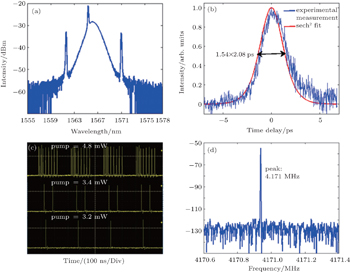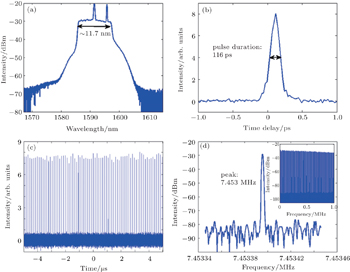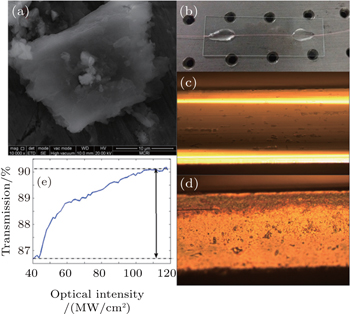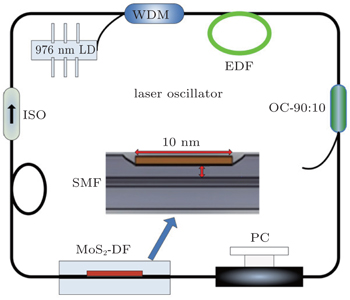† Corresponding author. E-mail:
Project supported by the National Natural Science Foundation of China (Grant No. 61378024).
We report on the generation of conventional and dissipative solitons in erbium-doped fiber lasers by the evanescent field interaction between the propagating light and a multilayer molybdenum disulfide (MoS2) thin film. The MoS2 film is fabricated by depositing the MoS2 water–ethanol mixture on a D-shape-fiber (DF) repetitively. The measured nonsaturable loss, saturable optical intensity, and the modulation depth of this device are 13.3%, 110 MW/cm2, and 3.4% respectively. Owing to the very low nonsaturable loss, the laser threshold of conventional soliton is as low as 4.8 mW. The further increase of net cavity dispersion to normal regime, stable dissipation soliton pulse trains with a spectral bandwidth of 11.7 nm and pulse duration of 116 ps are successfully generated. Our experiment demonstrates that the MoS2-DF device can indeed be used as a high performance saturable absorber for further applications in ultrafast photonics.
Fiber-based pulse laser has received special attention in the field of scientific research due to the growing needs of industry.[1–5] In the past decades, passively mode locking technique has been proved to be a simple and effective way to achieve the ultrashort pulses.[6,7] For such a technique, saturable absorber (SA) is a crucial device and has experienced rapid development from semiconductors to nano-sheet materials.[8–11] Especially, remarkable researches based on two-dimensional (2D) nanomaterial (including grapheme and topological insulator) have been reported for their advantages of easy fabrication, wide working wavelength, and controllable modulation.[12] Recently, it is found that molybdenum disulfide (MoS2) could also be fabricated as 2D nanosheet, which exhibits stronger saturable absorption and higher relaxation time (30 fs) than graphene at the wavelength of 800 nm.[13] Zhang et al. have obtained mode-locked dissipative soliton (DS) at 1 μm by a fiber pigtailed MoS2 SA which possessed a modulation depth of 9.3% and a saturable intensity of 15.9 MW/m2.[14] Moreover, by introducing suitable defects, Wang et al. have fabricated broadband few-layer MoS2 SAs at the wavelengths of 1.06, 1.42, and 2.1 μm.[15] On the other hand, in order to improve the performance of the SA, particularly the damage threshold, a new fabricating method known as evanescent-light deposition was introduced.[16–20] Owing to the evanescent wave working mechanism, only part of the transmitting light power interacted with the SA, so the SA device could endure much higher power than the SA fabricated with a quartz plate or on the fiber end facet. Moreover, the interaction length between the light and the SA was controllable as needed. In summary, the evanescent-light deposition is usually based on microfiber or D-shape-fiber (DF). Compared with the microfiber, the DF presents a high flexility. By combining the DF with MoS2 SA, the bound-state and single-pulse-state conventional solitons have been obtained in Ref. [21]; moreover, dissipative soliton mode locking and conventional soliton were both achieved in Ref. [22]. However, in those reports, due to the high nonsaturable losses (∼75% and ∼89%) of the MoS2-DF SA, the laser thresholds of conventional soliton mode locking are very high (43 mW and 56 mW). So lowering the nonsaturable loss of such an SA device is still a challenge to researchers.
In this paper, we are to answer this question. We report on the generations of conventional and dissipative solitons in erbium-doped fiber lasers with different net cavity dispersions by inserting an MoS2-DF SA. The nonsturable loss, saturable optical intensity, and the modulation depth of the MoS2-DF SA are measured to be 13.3%, 110 MW/cm2, and 3.4% respectively. The mode locking of bunch-state conventional soliton can be self-started at a very low pump threshold of 4.8 mW. By reducing pump to 3.2 mW, single pulse operation can be obtained, which features a 3-dB spectral bandwidth of 1.99 nm, a pulse duration of 2.08 ps, a repetition rate of 4.17 MHz, and an average output power of 34.67 μW. By further increasing the net cavity dispersion to normal regime, the stable DS pulse trains are successfully generated at a pump power of 150 mW. The spectral bandwidth, pulse duration, repetition rate, and average output power are 11.7 nm, 116 ps, 7.45 MHz, and 6.91 mW respectively. Our experiment demonstrates the high performance of the MoS2-DF SA.
To integrate the MoS2 nanosheets onto the DF, we firstly disperse the MoS2 in a water-ethanol mixture. The preparation of the MoS2 solution is similar to that in Ref. [21]. By depositing the MoS2 solution on a quartz plate, we measure the scanning electron microscope (SEM) image of the MoS2 nanosheets as shown in Fig.
For the DF, the distance between the surface of the D-shape plane and the upper surface of the fiber core is 5 μm, the length of D-shape plane is 10 mm. The DF is fixed on a glass plate. Firstly, we inject a visible light into the DF, and no distinct evanescent wave can be observed as shown in Fig.
Having prepared the MoS2-DF SA, we insert the mode-locking device into the fiber laser cavity. The configuration of proposed fiber laser system is schematically shown in Fig.
Firstly, we set the intra-cavity dispersion at the anomalous regime to confirm the potential of the MoS2-DF SA for conventional soliton pulse shaping. The lengthens of EDF and total SMF are 6 nm and 49 m respectively, the net dispersion is estimated at –0.82 ps2. Self-starting mode-locking of multiple pulses is successfully obtained with appropriate PC orientation and a pump power of 4.8 mW. As shown in Fig.
 | Fig. 3. Experimental results: (a) optical spectrum, (b) oscilloscope trace, (c) autocorrelation trace. |
A notable feature of this laser is that it has the ultra-low operating pump, and single pulse mode-locking can be obtained under 3.2 mW, which is much lower than those in Refs. [21] and [22]. It is due to the very low nonsaturable loss of the MoS2-DF SA device.
Furthermore, we change the intra-cavity dispersion to the normal regime to test the potential of MoS2-DF SA for DS pulse shaping. The lengthens of EDF and total SMF are 17 m and 10.5 m respectively, the dispersion is estimated at 0.12 ps2. Self-starting mode-locked DS is successfully generated when the pump power reaches 150 mW, and the output characteristics of the fiber laser are summarized in Fig.
 | Fig. 4. Optical spectrum (a), pulse shape (b), oscilloscope trace (c), and RF spectrum (d) of the mode-locked DS. |
As the pump power is increased, the mode locking of DS is destroyed and noise-like mode locking state appears. However, the noise-like mode locking state can be maintained even if the pump power is increased to a maximum available value of 650 mW. Moreover, with further reducing the pump power to a suitable level, mode locking of DS can be obtained again. It demonstrates that the MoS2-DF SA possesses an ultra-high optical damage threshold.
In this work, we obtain both conventional soliton and DS in the EDF laser by inserting a MoS2-DF SA. Taking advantage of the low nonsaturable loss and high saturable absorption effect of the SA device, the laser threshold for mode locking is much lowered. Moreover, the optical damage is not observed even under a largest pump power of 650 mW, which proves the high performance of the SA device in our fiber laser.
| 1 | |
| 2 | |
| 3 | |
| 4 | |
| 5 | |
| 6 | |
| 7 | |
| 8 | |
| 9 | |
| 10 | |
| 11 | |
| 12 | |
| 13 | |
| 14 | |
| 15 | |
| 16 | |
| 17 | |
| 18 | |
| 19 | |
| 20 | |
| 21 | |
| 22 | |
| 23 |




